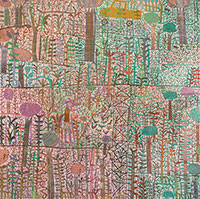
Robert Ryan’s new series of works again engages the viewer in a poetic linking of humanity and the natural world. Picture surfaces pulse with linear activity and an astounding array of biomorphic shapes. Sociological and ecological implications are ever present. The exhibition’s title, I Found an Old Box of Paint, may seem curious but Ryan imparts that it has both a metaphorical and quite literal relevance.
‘I opened an old carton of oil paints that I had discovered during the packing up of my print studio below the Barebones Gallery in Bangalow,’ he explains. ‘Long forgotten, it had been stored away when I was preparing to go overseas in the early 2000’s. Some of the tubes would have been from the mid 90’s… a lot of memories in that box!’ Ryan’s early paintings were ablaze with those colours, however in recent times his penchant has been for an increasingly monochromatic palette. Relocating to Tasmania’s relatively isolated north-east coast engendered a deeply contemplative attitude. Sole, constant companion is his dog, Kandi. The absence of colour in his paintings expressed the quietude, the moods of estrangement and acceptance.
Finding that box with its many-hued contents, some oils still usable, proved serendipitous and affirmed Ryan’s resolve to reintroduce colour and vibrancy into his artwork. ‘Because everything is so bleak in the present-day world, I’m attempting to play a small part in lifting spirits,’ he offers. The tiny, reworked paintings New Growth and Undertow mark the transition. In New Growth, the solitary figure sitting under a tree symbolises Ryan’s ruminations. A couple holding hands look towards a tip of sprouting foliage, its pale green hue the only colour in the simple, essentially black and white image. Divided into wavering segments, Undertow represents the current of negativity and doubt that threaten to disrupt everyday doings and strivings. Dominating the scenario in colour, shape and attitude, a spotted red dog stands confident upon a sturdy branch, seemingly oblivious to the monochromatic denizens below.
While the title of the work Blue Bird may bring to mind connotations of happiness, hope and renewal, for Ryan it has a somewhat different ‘slant’. He tells it alludes to an encounter in a Dublin pub many years ago. A man he’d been chatting to departs and a third-party makes comment that the bloke was ‘a real character – a dreamer, and if one looked closely, you could see the blue birds fluttering around his head’. An expression Ryan had never heard before, it informs the imagery of a farmer pursuing a dream that is perhaps not sustainable in the long term. Compositionally, Blue Bird is an exceptionally accomplished piece. The dramatic red shape that divides the painting signifies a fence separating a farmer’s carefully tended cultivations from the woodland beyond. Its centrality and striking colour are deftly counterbalanced by the red dog entering the picture frame on the left. Tree tops are overtly circular and the stripes across their trunks are replicated in the farmer’s shirt. Arms outstretched, the farmer farewells the now departing blue bird.
Akin in the rendition of foliage and shapes is Where the Rainforest Meets the Beach. Memories of life in the NSW Northern Rivers region imbues the painting with a nostalgic ambience. A figure seated at the forest’s edge gazes out to the ocean. Another lies supine in a sandy expanse, just absorbing the warm, immersive experience of place.
Colour flourishes in subsequent works. The Undergrowth image depicts a bemused man standing amidst a vast profusion of vegetation. All manner of creature is subtly camouflaged within the melange of rich, complimentary red and green tangles. The larger, pastel-hued Abandoned Chickens conjures an even greater sense of forest enclosure. Unbounded, the totemic-like minutiae and linear orchestration amplifies the atmosphere of thrumming seclusion. Having left his yellow ‘ute’ at the fringe, a person has trekked deep into the wilds in search of a group of abandoned chickens. The depiction has factual significance. Ryan has often wended his way through the thickets of a nearby reserve in order to feed a flock of roosters that had been set loose rather than slaughtered.
Ryan too, owns a 4WD utility vehicle. In ‘celebration of 21 years of loyal service’ it is featured as a 3D work in the exhibition. The pinewood body fashioned by his friend Graham Derbyshire, is lavishly decorated with Ryan’s characteristic colourful patterns. ‘Think Filipino jeep’, he quips. Underneath the chassis Ryan has painted and named a number of marsupials. Environmentally pertinent, these black and white motifs serve as a cautionary reminder to slow down when driving along country roads.
Understanding that the natural world is fundamentally made up of vibratory connective energy, Ryan has released his imagery from traditional perspectives. The paintings induce the kind of reverie that one might experience when wholly encompassed by nature. We respond instinctually to the infinite complexity of form, the rhythmic undulations and colours. Contemplative works of great delicacy and aesthetic fulfilment, they affirm Paul Klee’s famous tenet, ‘Art does not reproduce the visible, rather, it makes visible’.
Receive e-mail updates on our exhibitions, events and more
Subscribe Now